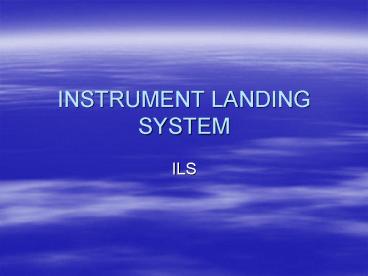INSTRUMENT LANDING SYSTEM - PowerPoint PPT Presentation
1 / 15
Title:
INSTRUMENT LANDING SYSTEM
Description:
ILS provides an aircraft with precision horizontal and vertical guidance to the runway. ... The localizer may be offset from runway centerline by up to 3 . Localizers ... – PowerPoint PPT presentation
Number of Views:5602
Avg rating:5.0/5.0
Title: INSTRUMENT LANDING SYSTEM
1
INSTRUMENT LANDING SYSTEM
- ILS
2
PRECISION APPROACH
- Non-precision approaches supply the pilot with
horizontal guidance only. (VOR, NDB, Localizer,
Loc. B/C, GPS without VNAV) - Precision approaches supply the pilot with
horizontal and vertical guidance. (ILS, MLS, PAR,
GPS with VNAV) - ILS is the primary international precision
approach system approved by ICAO and protected
until 2010. - ILS provides an aircraft with precision
horizontal and vertical guidance to the runway.
3
TYPICAL ILS INSTALLATION
4
(No Transcript)
5
LOCALIZER
- Localizers operate in the VHF range and provide
horizontal course guidance to runway centerline.
Transmitters are located on the centerline at the
opposite end of the runway from the approach
threshold. - The signal transmitted consists of two fan shaped
patterns that overlap at the centre. The overlap
area provides the on-track signal. - The angular width of the beam is between 3and
6. Normally width is 5, resulting in full scale
deflection at 2.5. The width of the beam is
adjusted to be 700 feet wide at runway threshold. - The localizer may be offset from runway
centerline by up to 3. Localizers offset more
than 3 will have an identifier beginning with X,
aligned localizer identifiers begin with I. - A cautionary note will be published in the CAP
whenever localizer is offset more than 3.
6
(No Transcript)
7
(No Transcript)
8
(No Transcript)
9
- Normal reliable coverage of localizers is 18nm
within 10 of either side of course centerline
and 10nm within 35. - Localizer installations provide back course
information, and non-precision localizer back
course approaches may be published. (ignore all
glide path information on back course) Normally
glide path will flag off. - Caution a localizer signal is transmitted
differently than a VOR radial. Aircraft receivers
are not supplied with azimuth information
relative to magnetic or true north. It is simply
a beam aligned with the runway centerline. For
this reason CDIs will display normal sensing
characteristics when flying in the same direction
as front course alignment, but reverse sensing
when traveling in the direction of back course
alignment. (HSI will normal sense anytime front
course direction is set on head of track bar.)
10
LOCALIZER
11
Glide Path
- Glide path information is paired with the
associated localizer frequency. - The glide path is normally adjusted to an angle
of 3 (may be adjusted 2 to 4.5) and a beam
width of 1.4(0.7 for full scale deflection). - The antenna array is located approx. 1000ft from
the approach end of the runway and offset approx.
400ft. (if glide path is followed to the pavement
touchdown point will be at the 1000ft markers) - In installations with an ILS serving both ends of
a runway the systems are interlocked so only one
can operate at a time. - Note on a standard 3 glide path 320ft/1nm can
be used to verify.
12
FINAL APPROACH FIX
- Typical final approach fixes are NDBs in Canada,
but can also be identified by DME or VOR radial
and DME as published. - Fan Markers are commonly used in the US as a
means of identifying aircraft location along a
localizer. As the marker is reached a fan marker
light will illuminate in the flight deck (if
equipped).
13
ILS CATEGORIES
- CAT I operation down to a minimum of 200ft DH
and RVR2600 or ½ sm ground visibility when RVR
not available. - CAT II operation down to a minimum of 100ft DH
and RVR 1200ft. - CAT III minimums will be prescribed in the
carriers operating specifications, carriers
operations manual, or the CAP. (minimums are
further broken down into A,B, or C with a CAT
IIIC minimums being zero-zero). - Requirements CAT II/III approaches require
specific aircraft and airport capabilities. (ex
airport lighting, aircraft autoland) - Note when CAT II/III approaches are being
conducted the CAT II or CAT III hold line must be
adhered to.
14
RUNWAY LIGHTING AND TRANSMISSOMETERS
- The following must be fully serviceable to meet
CAT II/III standards - Airport lighting
- approach lights
- runway threshold lights
- touchdown zone lights
- centerline lights
- runway edge lights
- runway end lights
- all stop bars and lead-on lights
- essential taxiway lights
- ILS components
- localizer
- glide path
15
- RVR equipment
- CAT II- two transmissometers- approach end,
mid-field - CAT III- three transmissometers- approach end,
mid-field, departure end - Power source
- Airport emergency power as primary power source
for all essential system elements. - Commercial power available within one second as a
backup.

